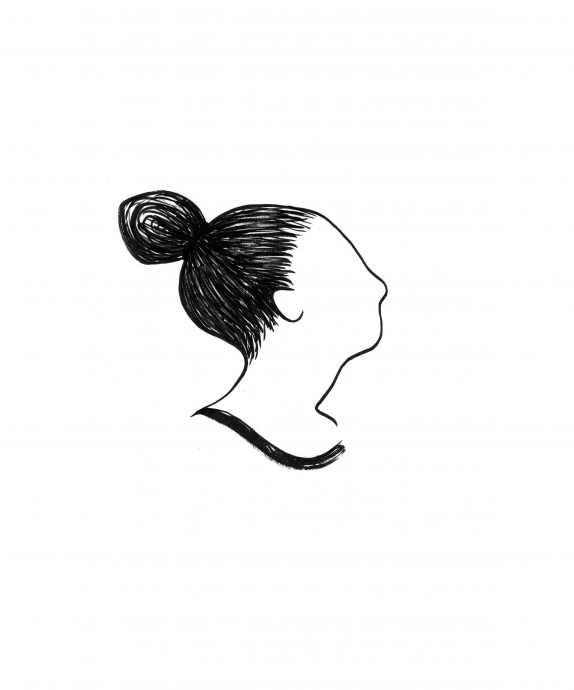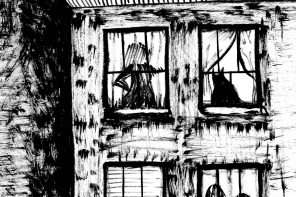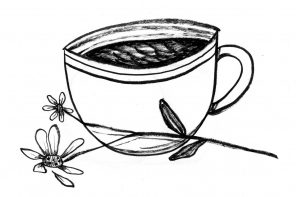Every time I entered Merce Cunningham’s Westbeth studio for class in the late 1970s, I saw this sign—Balance is more than not falling down—hung next to a black-and-white poster of company dancers. I spent those evenings dancing at Westbeth, watching sunsets over the Hudson River through one set of windows and the pink light reflected on the buildings of Union Square through the opposite set of windows. In that studio, you were both above the city and part of it. In my memory, it was a place of stillness, away from the swirl of teenage angst.
I took a beginner’s class in the small studio and then the elementary class in the big studio (I never got further), and I flirted with the idea of being a dancer until I realized my body would just never do it. Or maybe I was lazy: I could have taken more classes, instead of hanging out with my friends in Central Park after midnight, or sewing patches on my jeans while listening to a mish-mash of Rod Stewart, the Beatles, the Grateful Dead, and Patti Smith through headphones. Yes, I knew about Meredith Monk and Judson Dance Theater and that you didn’t need to be able to raise your foot over your head in order to be a modern dancer, but I was interested only in the precision and intelligence of Merce’s technique and choreography.
A field is a field—outdoors, bounded by trees or a stream, a road, a house, the sky—or indoors, bounded by mirrors, the edge of the sprung floor, the wings.
My parents, both painters, loved Cunningham. When they had the money, they went every time his company performed in New York. And when I was looking for someplace to take dance classes, my mother immediately suggested I call his studio. Although she had designed many sets before becoming an artist, my parents never took me to see plays; they always took me to see Merce.
In an interview with Jacqueline Lesschaeve, Cunningham said, “With the paintings of Jackson Pollock, the eye can go any place on the canvas. No one point is more important than another. No point necessarily leads to another.” A Jackson Pollock painting is a field.
I’ve been reading my journals from the 70s. They note that my mind sometimes wandered during dance class, returning to homework or drama with friends or—the worst—stomach-churning college applications. They also reveal a kid—self-conscious, trying to be literary, terrified of interacting with the other students at Westbeth who all seemed older, more mature. But being at that studio, where I breathed the same air as artists, including someone I considered a genius, allowed me to imagine a life in which creativity and rigor replaced the pettiness of high school. There, praise was rare but earned, and I could feel in my body the moments when hard work became dancing.
In a field, you don’t just think about how you might occupy space but how you can move through it.
Of course, it was a rare treat when one of the company members or Merce himself taught that elementary class, but my favorite teacher was Kilina Crémona, whom I called “hard mistress” in my journals. If I looked at her during class, she would shrug and shake her head, but once she smiled and nodded. I made note of that. She was tiny and French and put her short blond hair up in little braids or pigtails with a zillion clips and rubber bands. She would come up behind you—even behind the tallest men in the class—place her hand at the base of your skull and literally lift you higher. This should not have been physically possible for her to do, but she did it. “Grow yourself. Go to the maximum of yourself,” she would say. Sometimes we could barely breathe.
I didn’t become a dancer. I became a writer instead. This year, the centenary of Cunningham’s birth, I’ve been writing about him, his dances, and his choreographic methods, trying to figure out why, several decades after taking those classes and ten years after Cunningham’s death, I still care, why I continue to seek out performances of his work, watch videos of others on repeat, read and reread the short essays Cunningham wrote about dance, and read and watch interviews with his former dancers.
If a spatial field is not frontal, a temporal field is not linear. In a temporal field, neither a dance nor a story needs to lead up to a climax. “The continuity,” Cunningham wrote, “is constantly unpredictable rather than as though you were being led up a path.” The Piazza San Marco in Venice is a field and became even more of a field when Cunningham’s company danced there. That field moved when the dancers picked up their chairs and took them to another part of the piazza. Art is a mutual field of time and space—and sometimes words.
“Don’t just copy the shape,” Kilina said. “See what is and do it.” We were trying a slow sideways jump, from a plié in second position onto one leg, the other extended. A tall man, with a lot of power in his legs, could do these jumps very high. As he finished one, Kilina said, “I wish you could do it with a knapsack filled with brown rice so you could feel the weight.” Then as he went into his plié, she jumped on to him, piggyback, her legs around his waist and arms around his neck. “Now do it,” she said. He couldn’t move but we all got the idea.
In Ocean, over one hundred musicians, playing a cacophony of lovely and various underwater sounds, surrounded an audience that surrounded a circular stage set in the middle of a circus building or a quarry. Every side was the front. No spot was the center. The fifteen dancers in their purple unitards curved space, hooked themselves through solos, duets, trios, quartets, sometimes simultaneously. Sometimes they moved just in time to catch, push, or turn another dancer, sometimes just in time to lift another dancer by one leg during a jump or to, unexpectedly, make a mirror. They occupied every place, but, still, Merce told his dancers, “Just go a little further, so that the flatness disappears.”
Sometimes Kilina chased us around the room, yelling, “Move! Move! Move!” Sometimes she said, “No. Dance is not a habit.” She said this especially to students who had a lot of ballet training, who always held their arms just so. Often she would hold class with her back to the windows instead of the mirror, and the students who thought they’d cleverly situated themselves at the rear of the room found themselves in the front. “Oh, no,” she would said say as they tried to inch themselves to safety. “You stay up here.”
“For me,” Cunningham said, “the subject of dance is dancing itself.”
“I don’t work through images or ideas. I work through the body.”
“Ideas concern something being exactly what it is in its time and place, and not in its having actual or symbolic reference to other things. A thing is just a thing. It is good that each thing be accorded this recognition and this love.”
In a field, drama comes from opposition(s), not from narrative. The drama progresses slowly over time, one movement invoking the memory of another similar movement, one writing recalling another writing, or instantaneously, an image, a mistaken word, a sudden shift in direction as one dancer follows another.
In that studio with its beautiful expansive view, you could not stay in a safe zone. Doing it, that is dance, you were called to do the maximum, to move beyond habit. You might even fall.
A field, like a brain, is a “space in which anything can happen.”
Maya Sonenberg has been experimenting with writing about the arts since her first published story, which began “In Paris in 1911, the first Cubist baby was born.” Recent works about choreographer Merce Cunningham, including “The Field: Dancing for Merce Cunningham,” have been supported by the Velocity Dance Center in Seattle and by the Merce Cunningham Trust. Her other work includes two collections of stories, two chapbooks of prose and images (most recently After the Death of Shostakovich Père from PANK Books), and numerous other stories and essays. She teaches in the creative writing program at the University of Washington, Seattle and can be found at mayasonenberg.com and on Twitter @MzzS36019.
Acknowledgements
Thanks to the Merce Cunningham Trust and the Velocity Dance Center Seattle for their support of this work.
Quotes from Merce Cunningham come from the following works:
Merce Cunningham, Art Performs Life: Merce Cunningham/Meredith Monk/ Bill T. Jones (Minneapolis: Walker Art Center, 1998), pg 42.
Merce Cunningham and Jacqueline Lesschaeve, The Dancer and the Dance: Merce Cunningham in Conversation with Jacqueline Lesschaeve (New York – London: Marion Boyars, 1991), pgs 133, 139, 140.
Melissa Harris, ed., Merce Cunningham: 50 Years (New York: Aperture, 1997), pg 86.
Richard Kostelanetz, ed., Merce Cunningham: Dancing in Space and Time (Chicago and Pennington, NJ: a cappella books, 1992), pg 38.
Calvin Tomkins, The Bride and the Bachelors: Five Masters of the Avant Garde (New York: Penguin Books, 1976), pg 246.




